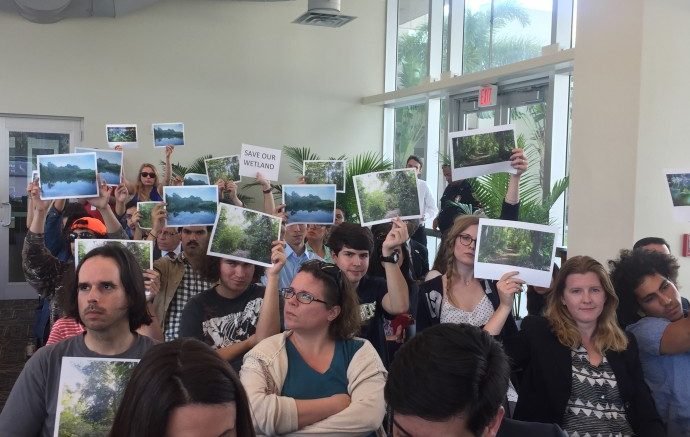Stephanie Espaillat/ Asst. News Director
The Board of Trustees meeting was in session Friday, March 11, to discuss building two practice fields over the northern part of the the Nature Preserve. The recent plans included a give and take resolution, where the University would take the 2.82 acres to the north, and provide a 2.95 expansion of the wetland area to the south.
Those who have been vigorously countering the University’s decisions were in attendance in order to anticipate what would be the outcome of FIU’s Nature Preserve. However, the ruling resulted in the unanimous decision in favor of the construction to build both fields in the controversial area, and to add the preserves expansion to the south. It was immediately followed by a walkout by the organized students.
President Mark B. Rosenberg opened the floor by stating “to the entire group of individuals who care, we want to figure this out,” when addressing the concerned group who were present during the meeting.
“It may not always go exactly the way that everybody wants. This is an issue that there is a lot of frustration everywhere. I want you to understand that we are working as hard as we can to do what’s in the best interest of the University,” he said.
However, some believe that the administration has been working in their best interest. Many have speculated the link between the University’s deal made with the Miami FC as possibly the instigation for the fast response to build these practice facilities. The deal allows the Miami FC to use the Ocean Bank Stadium, requiring $10,000 rent per match. While opposing teams will be allowed to practice at FIU for $2,500.
Aime Estevez, a junior studying environmental studies, presented her concern that the University was not responding to the real needs of the students at FIU.
“FIU made an agreement with Miami FC in October of last year, giving them use of the Ocean Bank Stadium,” Estevez said when reporting her claim.
“What that means is that it’s displacing some of our athletic students, and they won’t have as much area to practice. So it seems to stand that since October the FIU administration has known that their athletic students have needed another space to practice, and yet we were not made aware of the fact,” she said.
Estevez said, “Now I have to ask you what we’re standing for as a University? Are we standing for short term privatized monetary gain, or are we standing for the education of our students?”
“Because that area of land [referring to the Preserve] is invaluable to our students. Thousands use it for education, over 40 courses utilize that area for research. I definitely like us to be provided more time to discuss our options because it really seems as if we’re putting monetary gain over educational value,” said Estevez.
Chief financial officer, Kenneth Jessell addressed the accusation by saying, “This is not something that came up in October, November or December. This has been a long going concern for our students, and our student athletes.”
Jessell had suggested that the University has been aware of an issue that involves the student body, “our students have access to only one recreational field for many years and that field is used all during the night. We have events going on there from 11 pm up to 1 am in the morning.”
He had also mentioned that “we are the only school in conference USA without practice fields.”
“We expect our athletes to perform on the field, on the court and in the classroom which is the most important part. We want them to have access to the best facilities, and to be trained appropriately” said Jessell.
“As we discussed, and was required by this Board in December, our students have access to those fields at least 50 percent of the time, and we have been very consistent in that message. This is really for students and not just student athletes,” he said when addressing the concern on whether or not this decision was also for non-athletic students.
According to Jessell, The University had reportedly planned the project in December with an estimated budget of $1.9 million, and student government had agreed to contribute $500,000 towards its construction. While the Board has been considering many options over which approved plan would be the best location, and also would be the most cost effective. It was determined that the plan to build over the Preserve was the best option.
“The replacement of land was very important. So we are using 2.82, and we are giving back 2.95,” said Jessell when referring to the acres being provided at the south and being taken from the north. “We are putting in $400,000 from that $1.3 million savings to do the mitigation on the southern part of the newly created areas. In addition, the committee wanted a $2 million endowment that could be used with a 4 percent payout.”
Jessell had mentioned that the $80,000 a year will come from the endowment plan.
“In essence this gives us the equivalent of the endowment so we don’t have to wait months or years to have that endowment,” he said.
Jessell also reported that the environment planning committee currently has only $10,000 going into the improvement and maintenance of the preserve. Only $5,000 are coming from the university funds and $5,000 from the endowment.
He said that “we have never had the resources to make the type of living, learning, teaching, and research enterprise that I believe was always envisioned by the institution.”
“We are not stopping there; we are committed to this notion of earth environment and sustainability so we are going to be working on comprehensive university wide programs of conservation and sustainability,” he said.
Alexis Calatayud, MMC-SGC President, also detailed the student government resolution and what it actually insinuated, “Student Government recently signed a resolution that said ‘we support the preservation of the preserve, and not mutually exclusive, we support intramural fields on campus.’”
According to Calatayud, the message in the proposed resolution means preserving the preserve and does not include the northern portion.
She said “Students will have educational experiences they’ve never had before. Students will be able to be a part of the process of creating a conservation and sustainability plan.
“Not just for the preservation with $80,000 a year, but for the entire university of MMC and BBC. The faculty have said this is a unique opportunity they’ve never seen offered by this institution, and its an investment in the idea of conservation sustainability,” said Calatayud.
“Will the preserve be the same? No. Will we have unprecedented opportunities for the university, for student participation, and to explore what sustainability leadership means when faculty students and administration partner in a unique way, yes” she said.
However, Erin Berry, a political science and international relations student, said “The faculty senate resolution itself is really good, with the endowment and the security for the preserve. It is just concerning that this only seems to happen when they wanted to develop football fields on the preserve, and I don’t like having all of our environmental stewardship resolutions being the result of another development scheme.”
Berry shared her disappointment in Calatayud for not completely voicing a thorough representation that included the concerns of all students.
“It just seems like she could’ve taken a stronger stance in support of the 7,000 signatures that were signed for the petition instead of staying kind of quiet on it. Even if she was in support of it, she could have voiced the concerns. She could have taken what we had and actually been challenging the Board of Trustees, but it really did not feel like we had an ally up there,” Berry said.
“Where is the land survey? The environmental assessment?,” asked Berry when raising some of the unclear questions that haven’t fully been addressed. “Environmental Impacts take a full year to do, and it seemed like here they just went in for 4 months and said ‘well it looks like there’s invasives here mostly, so take it out.’”
The administration has recently suggested their conscious effort to be environmentally aware for the University by acknowledging the necessary demands to care for natural areas on campus and scheduling a prescribed burn in the pine rockland area for Monday, March 14.
Photo by Stephanie Espaillat/ Asst. News Director






Be the first to comment on "Board of Trustees approves Nature Preserve construction"